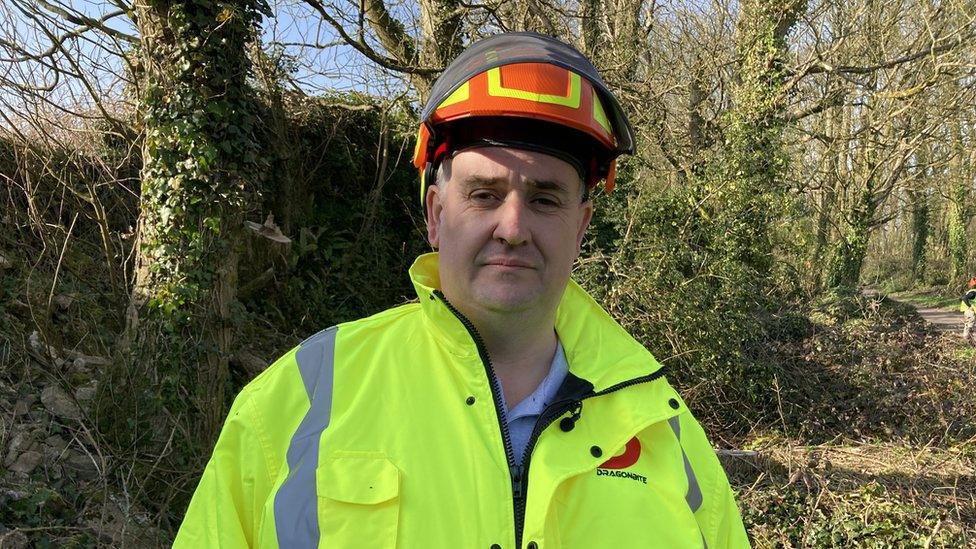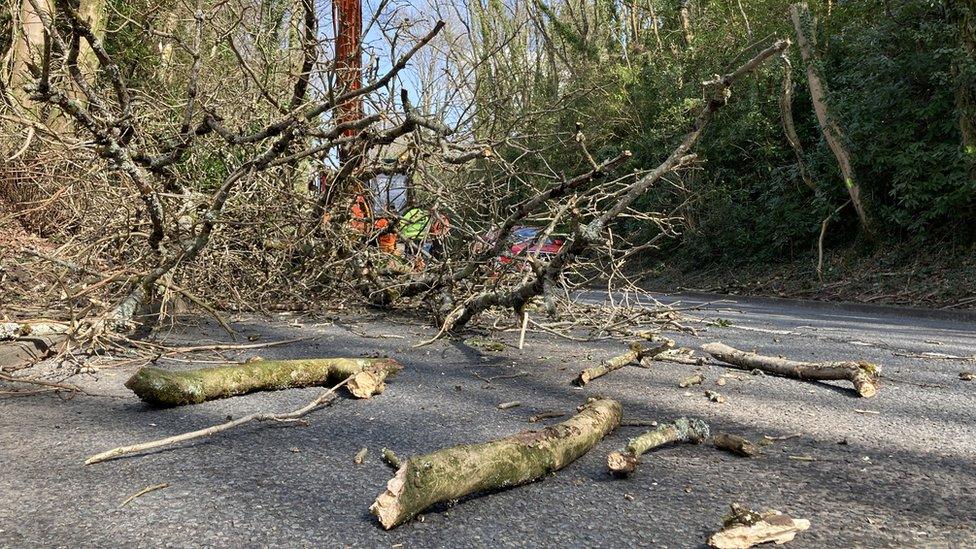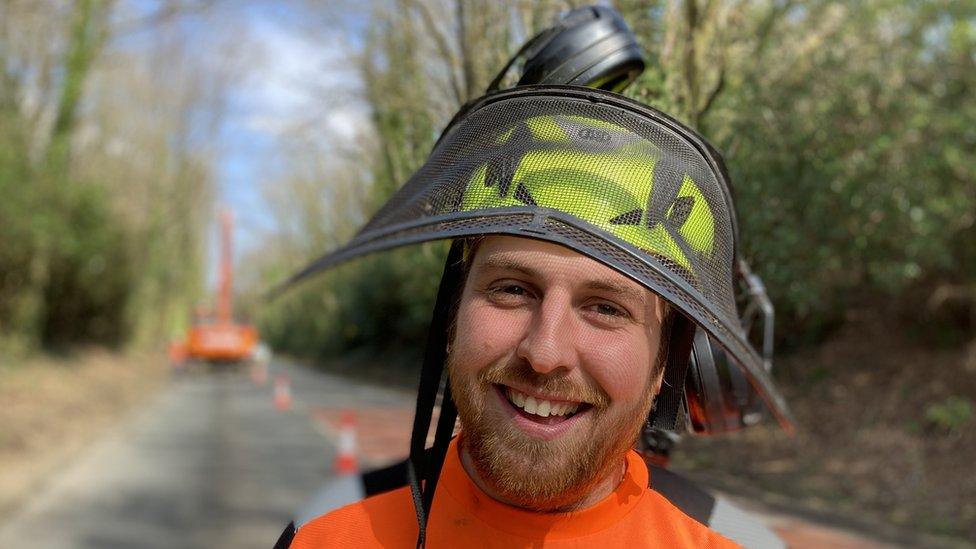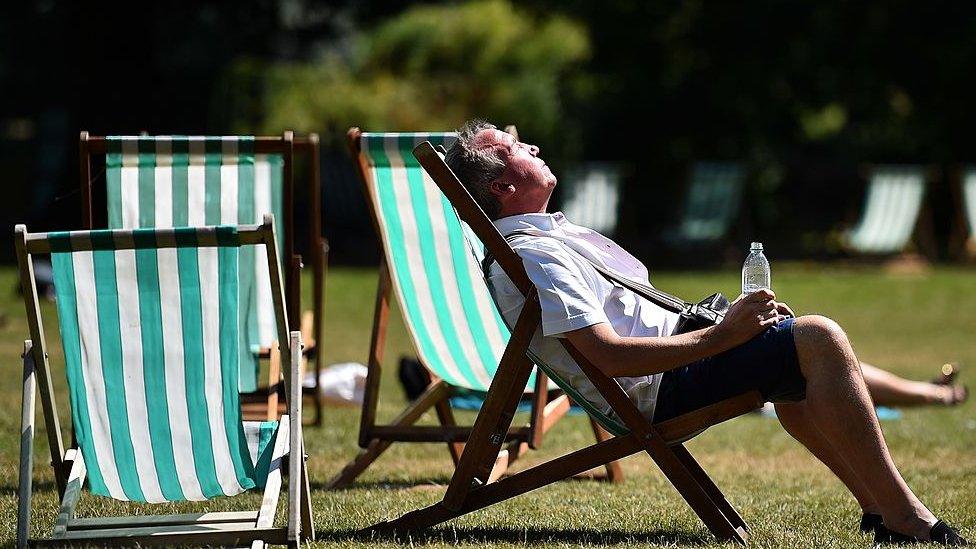Ash dieback: Exploding diseased trees risk lives - experts
- Published
Cutting down trees affected by ash dieback can pose a serious health risk
Diseased ash trees which "effectively explode" while being cut down pose a serious risk to people's safety, forestry organisations have warned.
Tree surgeons have been badly injured - some fatally - by falling branches.
They are being told not to go near the worst affected trees and use heavy machinery instead to bring them down.
There are calls too for more consistent advice for the public - some of whom may have dying ash trees in their gardens.
Ash dieback - a fungal infection - is now widespread 10 years after it was first detected in the UK, meaning millions of ash trees will ultimately be chopped down across the country.
Wales has been particularly badly hit with cases confirmed across 80% of the country, according to a 2018 survey.
Ash is a self-seeding tree, which has become one of the most common in the UK and is found along roadsides and railway lines as well as in woodland, parks and gardens.
'Very dangerous'

Sean Reilly says many people do not know that ash trees on their property are their responsibility
The trees die off over time, eventually becoming "very dangerous for anyone to go near or work on", said Sean Reilly, who runs a business supplying forestry equipment in Hirwaun, Rhondda Cynon Taf.
He said: "Traditionally a lot of trees would have been dismantled by rope and climbing - but with ash dieback you cannot do that.
"Effectively the trees will implode or explode because there's no strength left."
Following a spate of incidents, the Forest Industry Safety Accord (Fisa) has been advocating for the use of mechanical equipment for felling diseased ash trees - such as large grapple saws, with the operator housed in a protective cab.
A lot of the injuries being sustained are "life-changing", said Fisa CEO Gillian Clark, with "horrendous" situations affecting a close-knit industry.
"What we're seeing is skilled operatives dealing with a tree that doesn't necessarily go in the direction they'd expect it to go when it's dead and diseased," she said.
"It's a very difficult situation for them to read which is why we are possibly seeing this spike in incidents."

Diseased ash trees can "explode" when cut down, such as here along the A4109 at Crynant, Neath Port Talbot
But while the industry had become "much more receptive" in recent years, the organisation said it was still trying to get its message across
"We need to react now as an industry so we educate all our colleagues that these issues are present and they're going to get worse," said Mr Reilly, also a FISA director.
He added that many home owners and private landowners did not realise trees on their land were their responsibility.
But he said they should know that taking matters into their own hands without consulting an approved tree surgeon or contractor was "probably the most dangerous thing they can do".
The Health and Safety Executive (HSE) said it was concerned by an apparent increase in the number of serious tree work-related incidents, with storm damage also part of the picture.
Whereas HSE receives notice of about three tree work-related fatalities in an average year, in 2020-21 there were 10 with eight attributed to branches or a tree falling onto people.
In many near-miss cases, HSE said it could have proven fatal.

David Jack Thomas says he "can't express" how important it is to remove the trees safety
David Jack Thomas is the owner of The Arb Team, which is currently felling infected ash trees along the A4109 on behalf of Neath Port Talbot council.
"You do hear down the grapevine of injuries and deaths," he said.
Before the team's machine gets to work with its long extended arm, temporary traffic lights shut the road and everyone moves well back to avoid being hit by falling debris.
"Obviously there's a lot of paperwork involved and we're trying to use as many large machines as possible, trying to reduce manual handling - I can't express how important it is," added Mr Thomas.

I have ash dieback on my land - what should I do?
Consult an approved arborist, tree surgeon or forestry contractor for an assessment
Planning is crucial
Trees that are not in a hazardous location should be left alone
Exclusion zones should be set up around badly infected trees, and heavy machinery used to bring them down
Source: HSE
How does ash dieback develop?

'Universal approach needed'

Andrew Dowdon says local authorities need a universal stance on diseased ash trees
At the Penllyn estate near Cowbridge, in the Vale of Glamorgan, work to manage ash dieback across 350 acres (142 hectares) of woodland has been continuing for the past six years.
Andrew Dowdon, of Afan Treescapes, said it was one of the biggest challenges facing the industry from a safety perspective, and that local authorities needed a universal approach.
The message to the public was also not always consistent, he argued, and urged those with an infected tree to get it looked at in the early stages.
"As the tree deteriorates it becomes more difficult and often more costly - sometimes impossible - to bring down in a controlled manner," he said.
He said people needed to be on the look out, adding: "If you do see signs of dead wood in the tree, it's probably not the best place to picnic underneath."

WILD MOUNTAINS OF SNOWDONIA: Five farming families open their gates and share their lives
LAST CHANCE TO SAVE: Will Millard explores some of Wales’s hidden historic buildings

Related topics
- Published30 March 2022

- Published29 March 2022

- Published18 March 2022
